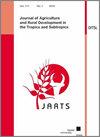碘化钾对苋菜叶片碘浓度及生长的影响
Q3 Social Sciences
Journal of Agriculture and Rural Development in the Tropics and Subtropics
Pub Date : 2021-05-25
DOI:10.17170/KOBRA-202104133654
引用次数: 0
摘要
土壤中碘含量低是低地和远离海洋的山区的常见特征。生活在这些地区的人们的饮食往往缺乏膳食碘,导致慢性碘缺乏综合征、甲状腺肿、听力损失和其他使人衰弱的疾病。2017年和2018年种植季节,在尼日利亚伊洛林大学教学与研究农场进行了一项田间实验,以使用农学方法评估苋对碘富集的反应。试验包括以0、3.5、7、10.5、14kg ha-1的叶面喷雾形式施用碘化钾(KI),以4、8、12和16kg ha-2的速率施用土壤。这些治疗是在随机完全区组设计中进行的四次重复。收集了有关株高、叶数、叶面积、作物生长速度、产量和碘叶浓度的数据。数据进行方差分析(ANOVA),然后使用Duncan的多范围检验进行平均分离,p<0.05。结果表明,在低施用水平下,施用KI可促进苋的生长,但在10.5和14kg ha-1的叶面施用可产生最高的碘叶浓度。虽然在苋中施用碘提高了碘叶的浓度,但在较高的施用率下会出现颜色变化,这可能会影响消费者对该蔬菜的可接受性。本文章由计算机程序翻译,如有差异,请以英文原文为准。
Potassium iodide influence on iodine-leaf concentration and growth of amaranth (Amaranthus cruentus L.)
Low iodine content in soils is a common feature in lowland and in mountainous regions far from oceans. The diets of the people living in these regions are often deficient in dietary iodine, resulting in chronic iodine deficiency syndrome, goiter, hearing loss and other debilitating diseases. A field experiment was conducted at the Teaching and Research Farm, University of Ilorin, Nigeria during the 2017 and 2018 cropping seasons, to evaluate the response of amaranths to iodine enrichment using an agronomic approach. The trial consisted of potassium iodide (KI) applied as foliar spray at 0, 3.5, 7, 10.5, 14 kg ha -1 and soil applied at the rates of 4, 8, 12 and 16 kg ha -1 . These treatments were in four replicates laid out in a randomized complete block design. Data were collected on plant height, number of leaves, leaf area, crop growth rate, yield and iodine-leaf concentration. The data were subjected to analysis of variance (ANOVA) followed by mean separation using Duncan`s Multiple range test p < 0.05. The results indicated that the use of KI improved the growth of amaranthus at the low level of application, but foliar application at 10.5 and 14 kg ha -1 yielded the highest iodine leaf concentration. Although application of iodine in amaranthus improved iodine leaf concentration, there was a colour change at higher rates of application which may affect the acceptability of the vegetable by consumers.
求助全文
通过发布文献求助,成功后即可免费获取论文全文。
去求助
来源期刊
CiteScore
2.30
自引率
0.00%
发文量
0
审稿时长
>36 weeks
期刊介绍:
The Journal of Agriculture and Rural Development in the Tropics and Subtropics publishes papers dealing with original research and review papers in the fields of plant production, animal nutrition and animal husbandry, soil science, rural economy and farm management, forestry and forest economy, veterinary hygiene and protection against epidemics.

 求助内容:
求助内容: 应助结果提醒方式:
应助结果提醒方式:


